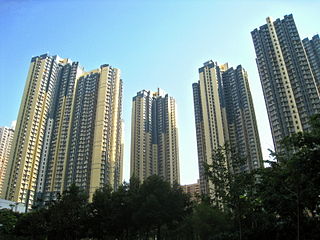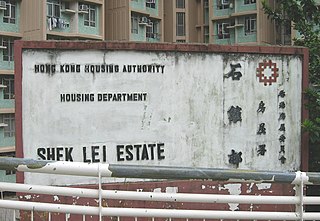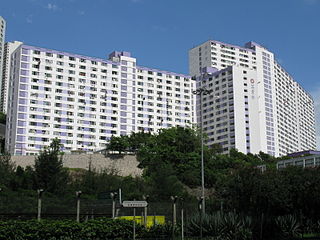
The Sai Kung District is one of the 18 districts of Hong Kong, a special administrative region of China. The district comprises the southern half of Sai Kung Peninsula, Clear Water Bay Peninsula in the New Territories and a strip of land to the east of Kowloon. Areas in the district include Sai Kung Town, Hong Kong Global Geopark, Tseung Kwan O and over 70 islands of different sizes. The administrative centre had been located in Sai Kung Town until the Sai Kung District Office was relocated to Tseung Kwan O recently. The district's population is concentrated in Tseung Kwan O, as of 2011. In 2011, the district was the third youngest district, with a median age of 39.3. Known as the "back garden of Hong Kong", Sai Kung has been able to retain its natural scenery. Many traditional customs and cultures are still retained in the rural villages.
Articles related to Hong Kong include:

Kwai Chung Estate is a public housing estate in Kwai Chung, New Territories, Hong Kong. It is the largest public housing estate in Kwai Tsing District and consists of sixteen residential buildings completed between 1997 and 2008.

Tin Hau temples in Hong Kong are dedicated to Tin Hau (Mazu). Over 100 temples are dedicated to Tin Hau in Hong Kong. A list of these temples can be found below.

Shek Lei Estate, also known by Shek Lei or Shek Lei Pui, the area where the estate is located, is a public housing estate in Hong Kong, situated in northeast Kwai Chung, New Territories near Shek Yam Estate, On Yam Estate and Shek Yam East Estate.

Kwai Fong Estate is a public housing estate in Kwai Fong, Kwai Chung, New Territories, Hong Kong. It was built in the reclaimed land of Gin Drinkers Bay, later the town centre of Kwai Chung, south of Kwai Hing Estate. Kwai Fong station is named after the name of the estate. It comprises twelve buildings with a total of 6,400 units and a shopping arcade.

Kwai Hing Estate is a public housing estate in Kwai Hing, Kwai Chung, New Territories, Hong Kong. It was built in the valley of Gin Drinkers Bay, later the town centre of Kwai Chung. Kwai Hing station is named after the name of the estate. It comprises 4 buildings with a total of 400 rental units and 1 shopping arcade.

Mountain Shore is a private housing estate in Tai Shui Hang, Ma On Shan, Sha Tin District, New Territories, Hong Kong. The estate is one of the Hong Kong Housing Society's Sandwich Class Housing Scheme projects converted into private developments.

Shek Yam East Estate is a public housing estate in North Kwai Chung, New Territories, Hong Kong. It has three blocks built in 1996. It was developed on the former site of Tai Pak Tin Temporary Housing Area, and not as a redevelopment of Shek Yam Estate. It is therefore considered as an independent estate.

Lai King Estate is a public housing estate in Lai King, Kwai Chung, New Territories, Hong Kong and is one of the oldest public housing estates in Kwai Tsing District. It is divided into two phases and consists of a total of seven residential buildings completed in 1975 and 1976 respectively. Lai King station is located between the two phases.

On Yam Estate is a public housing estate in North Kwai Chung, New Territories, Hong Kong. It is situated on land which was formerly the location of Shek Yam Temporary Housing Area and Shek Lei Temporary Housing Area. The estate consists of 8 residential buildings completed in 1994 and 1995.

Shek Yam Estate is a public housing estate in North Kwai Chung, New Territories, Hong Kong. It was the first Government Low Cost Housing Scheme estate in Kwai Chung. It had 8 blocks built in 1968, which were all demolished in the 1990s and 2000s.

Tsui Lam Estate is a mixed TPS and public housing estate located to the west of Po Lam in Tseung Kwan O, New Territories, Hong Kong. It is the second public housing estate in Tseung Kwan O and is the only public housing estate in Tseung Kwan O not built on reclaimed land. It has a total of eight residential blocks completed in 1988. Some of the flats were sold to tenants through Tenants Purchase Scheme Phase 6B in 2005.

Hau Tak Estate is a public housing estate in Hang Hau, Tseung Kwan O, New Territories, Hong Kong, near East Point City. It is the fourth public housing estate in Tseung Kwan O and consists of six blocks of Harmony I style, providing more than 4,000 rental flats built between 1993 and 1994.

Ming Tak Estate is a public housing estate in Hang Hau, Tseung Kwan O, New Territories, Hong Kong, near Tseung Kwan O Hospital. It is the fifth public housing estate in Tseung Kwan O and comprises 2 blocks of Harmony I style built in 1996.

The following is an overview of Public housing estates in Kwai Chung, Hong Kong, including Home Ownership Scheme (HOS), Private Sector Participation Scheme (PSPS), Sandwich Class Housing Scheme (SCHS), Flat-for-Sale Scheme (FFSS), and Tenants Purchase Scheme (TPS) estates.
The following is a list of public housing estates in Tsuen Wan, Hong Kong, including Home Ownership Scheme (HOS), Private Sector Participation Scheme (PSPS), Sandwich Class Housing Scheme (SCHS), Flat-for-Sale Scheme (FFSS), and Tenants Purchase Scheme (TPS) estates.

Public factory estates are blocks of factory buildings owned by the Government of Hong Kong. Built between the late 1950s and the early 1980s, most of these industrial buildings have been demolished during the 1990s and 2000s, while some have been converted and a few are still active. While these buildings are notable as witnesses of the history of manufacturing in Hong Kong and of the public housing policy of the Government of Hong Kong, they represent only a fraction of the industrial buildings of the territory: there were about 1,700 industrial buildings in Hong Kong in 2003.
















